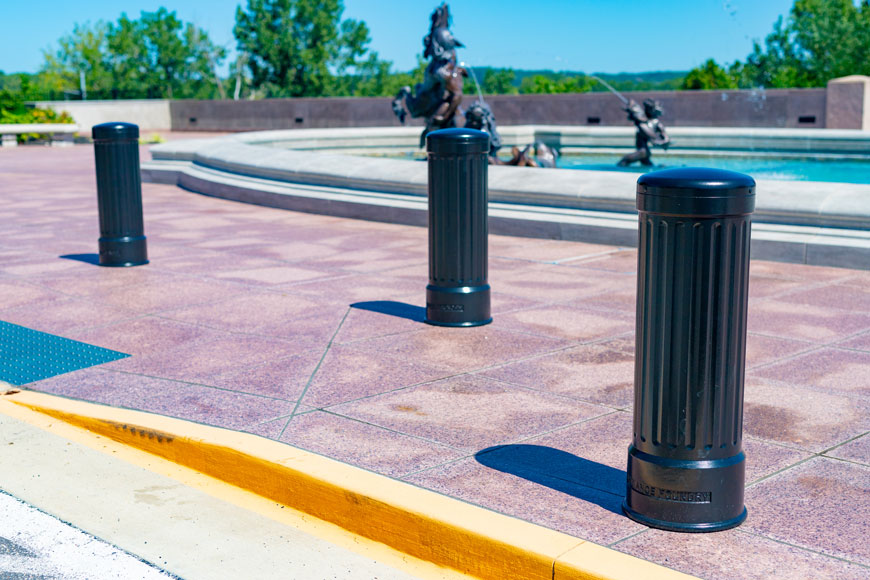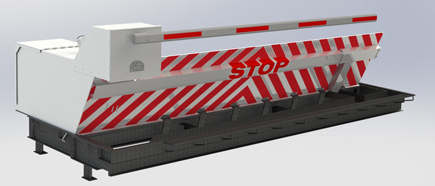Fascination About Wedge Barriers
Table of ContentsGetting My Wedge Barriers To WorkAll About Wedge Barriers


18 might be done faster, conveniently, and cost efficiently. FIG. In specific embodiments, the support 30 might be a steel frame including plates, light beams(e. g., I-beams ), and/or other frameworks that are secured within the foundation 14, which might be concrete. At the surface 12, a top side 28 of the anchor 30 might be at the very least partially revealed
, consequently enabling the accessory of the barrier 10 to the support 30. g., threaded openings)in one or more light beams or plates of the support 30 may be revealed to the surface 12. In this way, screws 32 or other mechanical fasteners may be used to protect the barrier 10 to the support 30. As the barrier 10 is placed to the surface 12 of the foundation 14, collection of particles and various other material under the barrier may be minimized, and components of the bather 10 may not be exposed to listed below quality environments. As suggested by referral numeral 52, the lifting mechanism 50 includes elements got rid of beneath the wedge plate 16. For instance, the elements 52 underneath the wedge plate 16 might consist of an electromechanical actuator, a cam, one or even more camera surfaces, etc. Furthermore, the training device 50 consists of a springtime setting up 54
The springtime pole 58 is paired to a cam(e. g., cam 80 shown in FIG. 4) of the training mechanism 50. The springs 60 disposed concerning the springtime pole 58 are kept in compression by spring sustains 62, consisting of a dealt with springtime assistance 64. That is, the set spring support 64 is taken care of about the foundation 14 et cetera of the bather 10.
Wedge Barriers for Beginners
The staying pressure used to
the cam to deploy the wedge plate 16 may might provided given an electromechanical actuator 84 or other actuator. The spring setting up 54 and the actuator 84(e. Wedge Barriers. g., electromechanical actuator)may operate together to equate the web cam and raise the wedge plate 16.
As pointed out above, the spring assembly 54 applies a continuous force on the webcam, while the electromechanical actuator may be regulated to apply a variable force on the camera, thus making it possible for the lifting and reducing( i. e., releasing and retracting )of the wedge plate 16. In specific personifications, the consistent force applied by the springtime assembly 54 may be adjustable. g., electromechanical actuator) is handicapped. As will be valued, the springtime setting up 54 might be covered and protected from debris or other elements by a cover plate(e. g., cover plate 68 shown in FIG. 4) that might be considerably flush with the raised surface area 38 of the structure 14. As stated above, in the released setting, the wedge plate 16 offers to block gain access to or travel past the barrier 10. For instance, the barrier 10(e. g., the wedge plate 16 )might obstruct pedestrians or lorries from accessing a building or path. As gone over above, the barrier 10 is connected to the support 30 protected within check my source the structure 14,

front brackets 71. As a result, the link settings up 72 might pivot and revolve to enable Your Domain Name the collapse and expansion of the affiliation settings up 72 throughout retraction and deployment of the bather 10. The linkage settings up 72 reason activity of the wedge plate 16 to be restricted. If a vehicle is traveling in the direction of the released wedge plate 16(e. For example, in one scenario, the security legs 86 might be prolonged throughoutmaintenance of the barrier 10. When the security legs 86 are deployed, the security legs 86 sustain the weight of the wedge plate 16 against the surface 12. Because of this, the lifting mechanism 50 might be shut off, serviced, eliminated, replaced, and so forth. FIG. 5 is partial perspective sight of an embodiment of the surface-mounted wedge-style obstacle 10, highlighting the web cam 80 and the cam surface areas 82 of the lifting device 50. Specifically, 2 webcam surfaces 82, which are referred to as reduced webcam surface areas 83, are special info placed below the web cam 80. The lower cam surfaces 83 may be repaired to the surface area 12 (e. As an example, the lower webcam surfaces 83 and the placing plate 85 might create a solitary piece that is safeguarded to the anchor 30 by screws or other mechanical bolts. Additionally, two webcam surface areas 82, which are described as top web cam surface areas 87, are placed above the webcam 80 and combined to (e. In other personifications, stepping in layers or plates may be placed in between the surface area 12 and the reduced webcam surface areas 83 and/or the wedge plate 16 and the upper webcam surface areas 87 As mentioned over, the camera
80 translates along the web cam surfaces 82 when the wedge plate 16 is lifted from the retracted setting to the released placement. In addition, as pointed out over, the spring setting up 54 (see FIG. 3 )might supply a pressure acting upon the camera 80 in the instructions 102 by means of springtime pole 58, which may decrease the force the electromechanical actuator 84 is needed to use to the camera 80 in order to actuate and lift the wedge plate 16. 1 )to the deployed setting(see FIG. 4). As shown, the cam 80 consists of track wheels 104(e. g., rollers), which get in touch with and convert along the web cam surfaces 82 during operation.